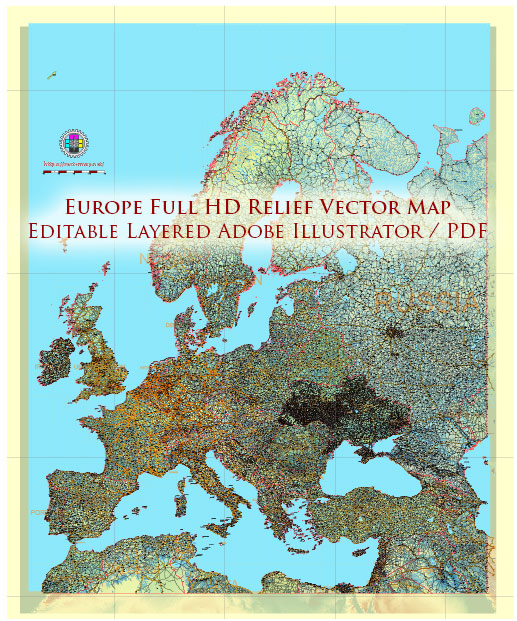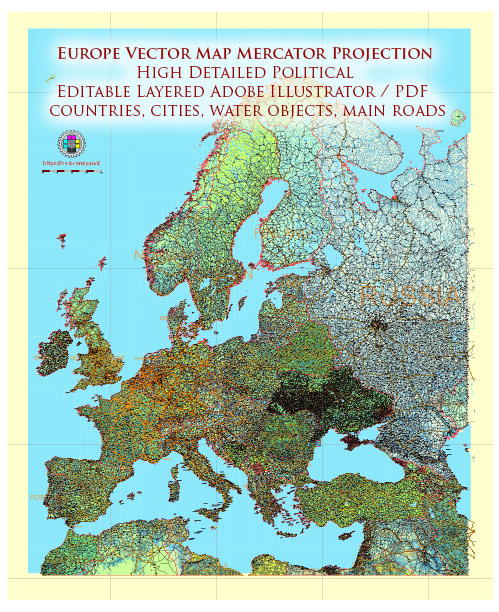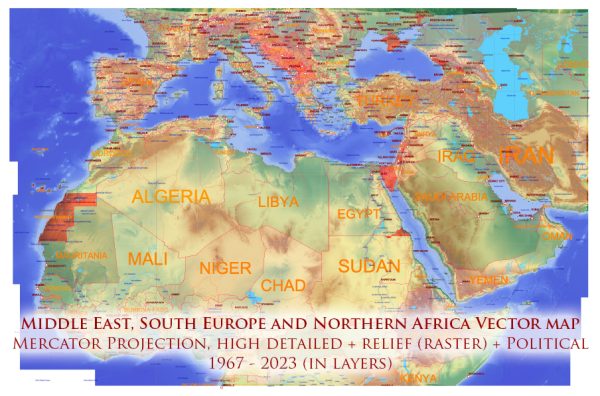The history of railroads in Europe is a complex and fascinating story that spans several centuries, marked by technological innovations, economic transformations, and social changes.
Vectormap.Net provide you with the most accurate and up-to-date vector maps in Adobe Illustrator, PDF and other formats, designed for editing and printing. Please read the vector map descriptions carefully.
Here is a detailed overview of the railroad history in Europe:
1. Early Concepts and Innovations:
- The concept of rail transport dates back to ancient times, but significant developments occurred during the 17th and 18th centuries.
- Wooden wagonways, early rail systems, were used in mining operations in England in the 17th century. These tracks consisted of wooden rails along which horse-drawn carts could move.
2. The Birth of the Steam Locomotive:
- The real breakthrough came in the early 19th century with the development of the steam locomotive. George Stephenson is often credited with building the first practical steam locomotive, the “Rocket,” in 1829.
- The Stockton and Darlington Railway, opened in 1825 in England, is considered the world’s first public railway. It primarily used steam locomotives for hauling both passengers and freight.
3. Railway Expansion in the 19th Century:
- The success of early railways in England inspired other European countries to adopt this technology. France, Belgium, Germany, and other nations quickly embraced railway construction.
- Railways played a crucial role in the Industrial Revolution by facilitating the movement of raw materials, finished goods, and people.
4. The “Railway Mania” and International Connections:
- In the mid-19th century, a speculative frenzy known as the “Railway Mania” swept through Europe. Investors poured money into railway projects, leading to a rapid expansion of rail networks.
- Railways became essential for international trade and travel. The construction of the Channel Tunnel, completed in 1994, directly connected the rail networks of the United Kingdom and continental Europe.
5. Technological Advancements:
- Continuous technological advancements improved railway efficiency and safety. This included developments like steel rails, air brakes, and improved signaling systems.
- Electrification of railways began in the late 19th century, with cities like Berlin and London pioneering the use of electric trains.
6. Impact on Society and Economy:
- Railways transformed the economic landscape by facilitating the movement of goods and people more efficiently than ever before.
- Urbanization increased as cities were connected by rail, and the speed of transportation opened up new possibilities for commerce and industry.
7. Nationalization and Modernization:
- Many European countries nationalized their railways during the 20th century. This allowed for better coordination and planning of rail services.
- High-speed rail services, such as the TGV in France and the ICE in Germany, revolutionized long-distance travel, setting new standards for speed and comfort.
8. European Union and Rail Transport:
- The European Union has played a significant role in harmonizing rail standards and promoting interoperability between different national rail networks.
- The creation of the European Rail Traffic Management System (ERTMS) aims to standardize signaling and control systems across Europe.
9. Recent Developments and Future Challenges:
- Investments in high-speed rail continue, and there is an ongoing focus on sustainability and reducing the environmental impact of rail transport.
- Challenges include maintaining and upgrading aging infrastructure, adapting to new technologies, and addressing the evolving needs of a modern society.
The history of railroads in Europe reflects not only technological progress but also profound social and economic changes. Railways have played a crucial role in shaping the continent’s development and continue to be a vital component of its transportation network.




 Author: Kirill Shrayber, Ph.D.
Author: Kirill Shrayber, Ph.D.